Dan Brown is the best-selling author of a series of mystery novels, including 'Angels and Demons,' 'The Da Vinci Code,' and 'The Lost Symbol.' The movie based on his novels, 'Angels and Demons,' showcases various historical structures in Italy. While one might initially dismiss it as a cliché, the movie delves into an intriguing theme—the conflict between religion and science—while immersing viewers in the ambiance of Italy. In the film, a criminal organization kidnaps cardinals on the day of the papal election. To rescue them, Robert Langdon, a professor of semiotics, journeys to Italy to uncover clues. In this article, I'll guide you through the movie's scenes set in Italy, accompanied by my own photos, and delve into the country's attractions and history.

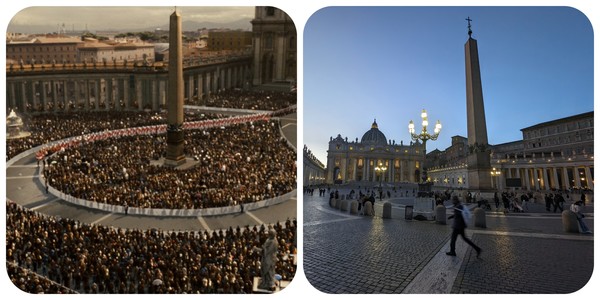
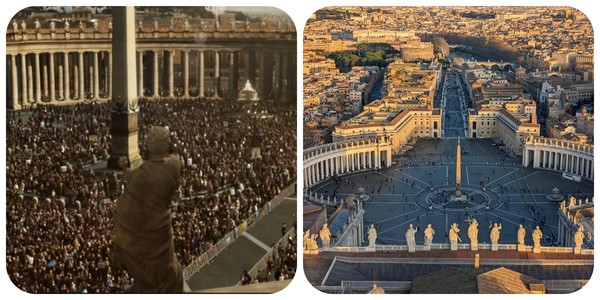
At the start of the movie, a scene unfolds with thousands gathered for the Pope's funeral in St. Peter's Square, also known as Vatican Square. Designed by Baroque master Bernini in 1656 and completed in 1667, the square's centerpiece is dominated by an ancient obelisk. This narrow, towering obelisk, originally erected in Egypt during the 13th century BC, served as a symbol of worship for the ancient Egyptians' sun god. In 37 AD, the obelisk was relocated to decorate the Nero Stadium in Vatican Square by the Roman emperor Caligula. Standing at 25.5 meters tall and weighing 330 tons, it ranks as the second largest obelisk in Rome. Flanking the obelisk are two fountains: one crafted by Maderno and the other by Bernini, the latter completing it following Maderno's design. Above the circular colonnade encircling the piazza are 140 statues of various shapes, sculpted by Bernini's pupils. The colonnade itself symbolically represents the embracing arms of Jesus enveloping Rome.
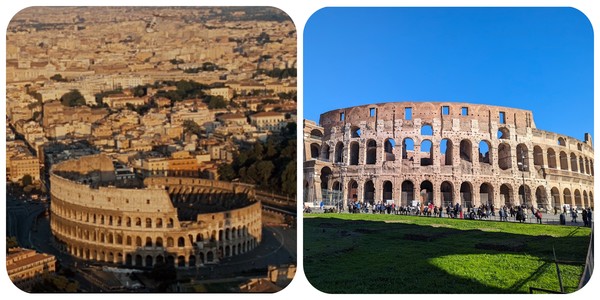
Four cardinals vying for the papal election are kidnapped by a criminal organization, which threatens to kill them and destroy the Vatican using stolen antimatter from a lab, showcasing the supremacy of science to the world. To locate the cardinals and the missing antimatter, Professor Langdon flies over the Colosseum in a helicopter. The name 'Colosseum' originates from the colossal statue of Emperor Nero situated nearby. This iconic amphitheater, known for its massive size, could accommodate around 50,000 spectators. Beyond hosting gladiatorial contests, the Colosseum served various purposes, including animal hunts, executions, and public events. While its spectacles may seem brutal to modern sensibilities, they provided ultimate entertainment for Roman citizens of that era, akin to our love for watching sports.

Professor Langdon heads to the Pantheon, suspecting it as the location where the kidnapped cardinal is being held. The Pantheon, Rome's oldest dome structure, derives its name from the Greek 'temple of all the gods.' The hemisphere forming the Pantheon's structure symbolizes the universe, while the hole at the top of its massive dome represents the sun, the center of the cosmos. Constructed using advanced technology available at the time, the dome spans an impressive 43.3 meters in diameter. The 9-meter opening allows natural light to illuminate the interior, eliminating the need for artificial lighting. Today, the Pantheon serves as the final resting place for significant figures in Italian history, including Raffaello.
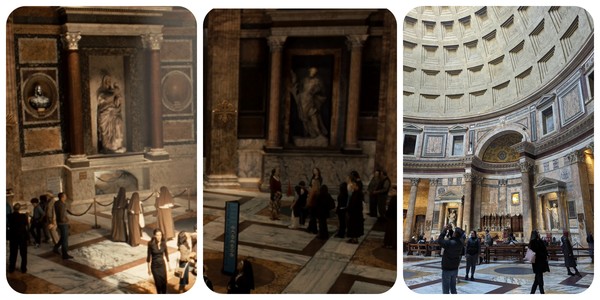
The statue on the left is a creation by Lorenzo Lotti, a student of Raffaello. Known as 'Madonna Del Rock,' it portrays a figure standing with one foot on a rock. On the right is a sculpture of St. Anastasio, crafted by Francesco Moderati in 1717.
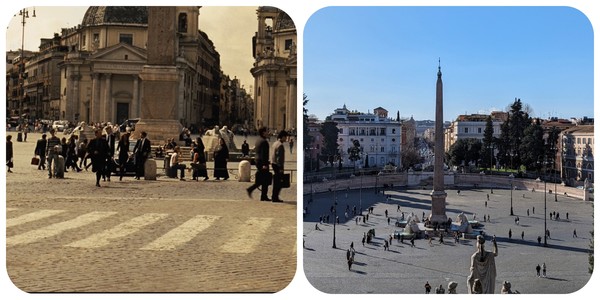
Contrary to Professor Robert Langdon's expectations, the kidnapped cardinal is nowhere to be found in the Pantheon. Realizing their misinterpretation of the clues, the professor and his group make their way to Piazza del Popolo. The name 'Piazza del Popolo' translates to 'people's square' in Italian. As the famous saying goes, 'All roads lead to Rome,' and indeed, this square was once the starting point for many roads leading out of Rome, making it a vital hub for travelers entering and exiting the city. At the center of the square stands an obelisk, brought to Rome by Emperor Augustus in 31 BC. Surrounding the square are exemplary works of Roman Baroque architecture, including the twin churches of Santa Maria del Popolo. Napoleon himself praised Piazza del Popolo as 'the most beautiful square in the world".
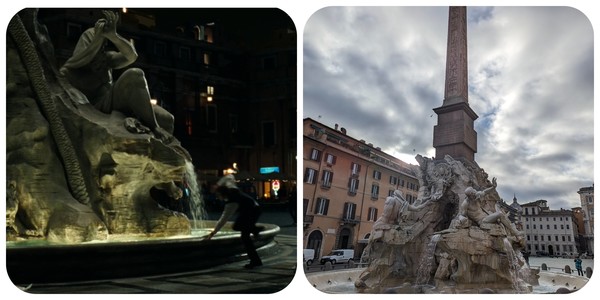
Professor Langdon predicts that the next place where the criminal organization will strike is Piazza Navona. While waiting there, the professor witnesses the kidnapper dropping the bound cardinal into a fountain and fleeing. Acting swiftly, Professor Langdon rescues the drowning cardinal, gaining crucial insight into the kidnapper's next move. Originally the site of a stadium built by Emperor Domitian, Piazza Navona underwent transformation in the 15th century, evolving into the vibrant square it is today. Renowned for its three fountains and stunning architecture, the square boasts several notable landmarks. At its heart lies the Fontana dei Quattro Fiumi (Fountain of the Four Rivers), designed by Bernini, a masterpiece adorned with depictions of gods and animals representing the Nile, Ganges, La Plata, and Danube rivers. An obelisk stands at the fountain's center, symbolizing the Vatican's dignity. Surrounding the square, Baroque-style buildings such as the Palazzo Borghese and the Doria Pamphilj Museum reflect the opulence and influence of the Roman aristocracy. Today, Piazza Navona bustles with street artists and offers an array of charming cafes, embodying the vibrant spirit of Roman life.

Professor Langdon apprehends the kidnapper at Castel Sant'Angelo. Originally built as tombs for Emperor Hadrian and his family, Castel Sant'Angelo later served as a fortress and residence for popes following the fall of the Roman Empire. It was fortified to safeguard the popes during the sack of Rome by the Goths in the 5th century and later served as a papal residence known as 'St. Michael's Castle' in the 6th century. Located in front of the castle is the ancient Sant’Angelo Bridge, connecting Rome's city center to Castel Sant'Angelo. The bridge spans 136 meters and is composed of three arches, bearing witness to centuries of history and serving as a vital link between the heart of Rome and the historic fortress.
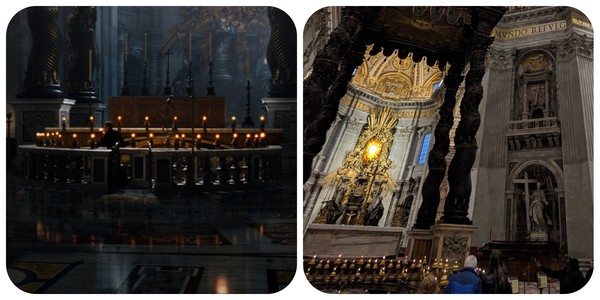
The mastermind behind the kidnapping and murder of the cardinals, along with the threat to destroy the Vatican using an antimatter bomb, is revealed to be the Camerlengo of the Holy Roman Church, who assists the Pope. Cornered, the Camerlengo flees to the basement of St. Peter's Basilica. There, he douses himself in oil and sets himself on fire, ultimately ending his own life. St. Peter's Basilica, built over the supposed site of Peter's tomb, is the largest cathedral in the world. A magnificent fusion of Renaissance and Baroque architectural styles, St. Peter's exudes grandeur and opulence. Its colossal dome, designed by Michelangelo, stands as the quintessential symbol of the basilica's majesty.
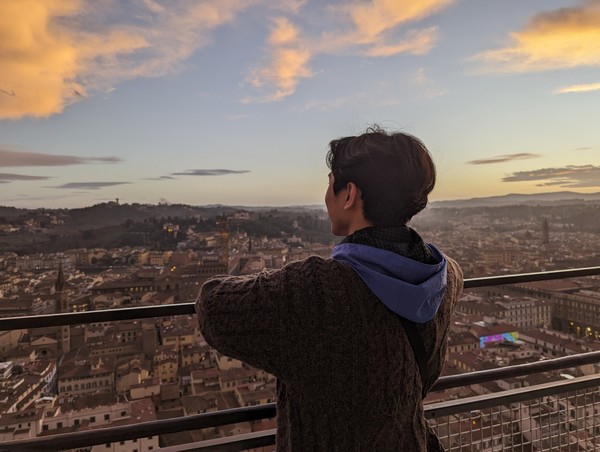
As I read 'Angels and Demons,' I found myself immersed in the vivid descriptions of Italy, envisioning the backdrop of the novel. Eager to experience it firsthand, I planned my trip to Italy, eagerly anticipating the sights of Rome and the grand cathedral depicted in the movie adaptation. Witnessing these scenes in person filled me with an indescribable sense of joy and awe. It's more than just a story set in Rome; it's an immersive experience that makes you feel like you're truly there, walking the streets and marveling at the ancient remains alongside the characters.

